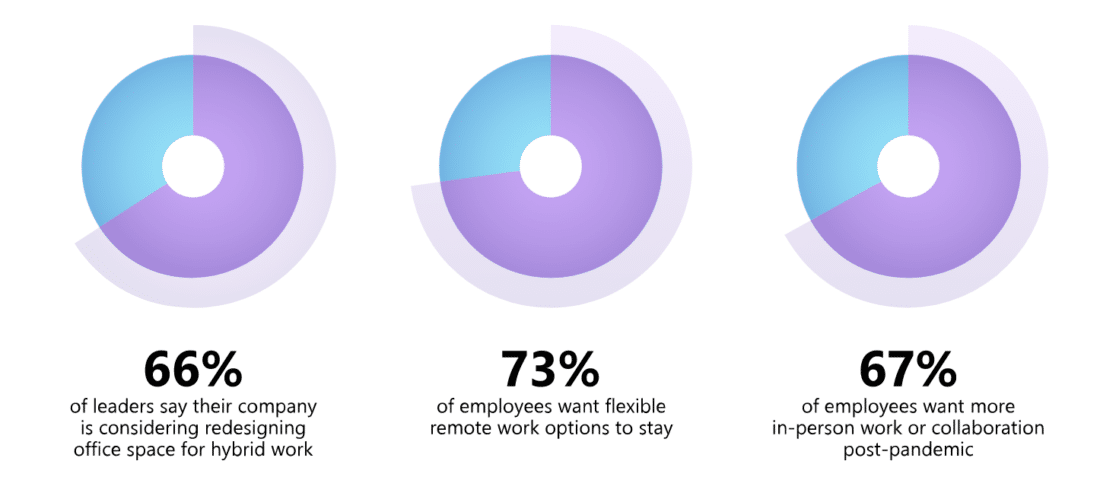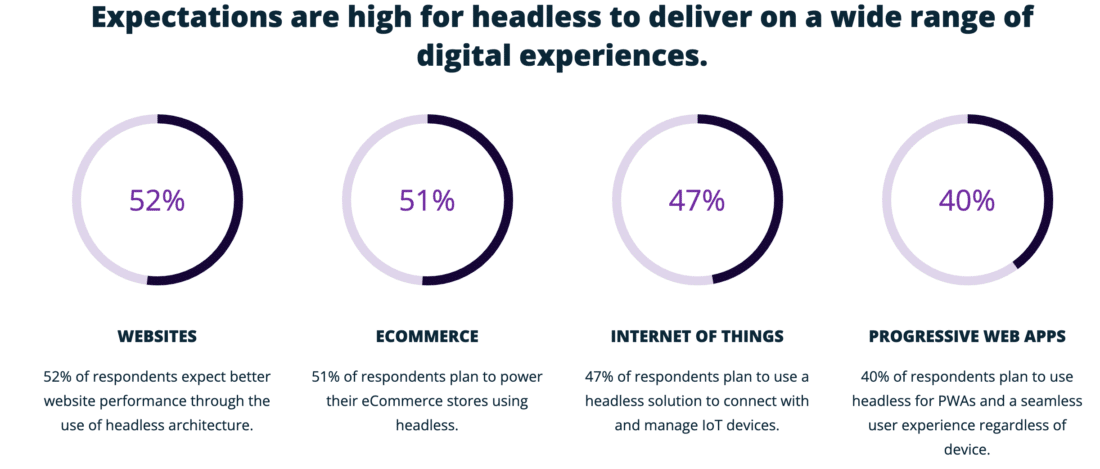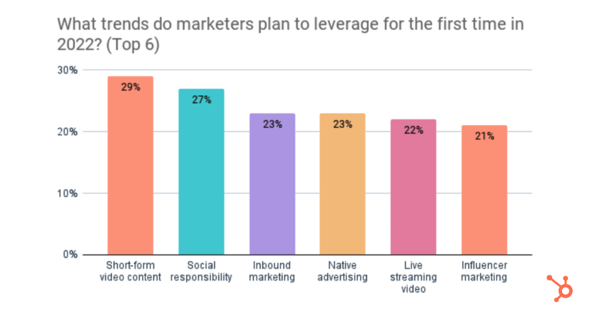We’re another year into the pandemic (insert collective groan here) and the way we connect, communicate, shop, work, and use technology to access products and services continues to redefine and renew itself. It seemed somehow like 2021 was just an extension of 2020. However, there was a sizable difference. This time around businesses already had the necessary framework and platforms in place to handle these challenges and address consumer needs.
Here’s a look at marketing trends in e-commerce, network security, and headless architecture in the age of Covid-19, as well as how investing in growth marketing can help guide your solutions.
Shop Talk
Stop us if you’ve heard this one before. E-commerce is here to stay. Deloitte projected e-commerce sales would grow 11% to 15% last year compared to 2020. The report further estimated that total e-commerce holiday sales would reach up to $218 billion.
In 2021, as people remained hesitant to shopping in person, e-commerce sales grew by 44%, resulting in higher revenues for many businesses. That said, close to 60% of consumers chose a hybrid shopping model during the holiday season, blending in-person shopping with e-commerce transactions. At the same time roughly one-quarter of consumers were expected to shop only online, completely bypassing the in-store shopping experience.
In other words, the preference to shop online will only increase consumer reliance on the e-commerce industry. Gartner estimates that by 2040, 95% of purchases will occur online. So if you don’t have an effective e-commerce process in place, there’s no time like the present to make up for the past.
1) It’s all about the user
The importance of creating a more intuitive user shopping experience for your customers cannot be overstated. Data-driven personalization can help facilitate that experience. But first you need to keep customers on your site. Studies have shown that 53% of consumers will bail if it takes over three seconds for a page to load. Instead of trying to spruce up your homepage with videos and flashy images, go for speed and reliability. As boring as it may sound, it works.
Any successful online shopping strategy must include making the customer feel valued. The more people feel valued, the more comfortable they are in making a purchase.
2) The write stuff
Websites with effective content marketing see six times higher the conversion rate as those without a solid content strategy. A compelling narrative increases brand awareness and can drive an emotional connection with your brand. Storytelling comes in many different forms, whether through a blog post or short-form videos. Don’t discount the power of a blog post. Brands with blogs have 434% more search engine-indexed webpages, which increases visibility through organic searches. The key is using content—compelling content—that will resonate with your target audience in a timely manner.
3) Consumer trends
E-commerce and shopping trends that once seemed novel are now the industry standard. In fact, according to Ernst & Young, 42% of consumers plan to fundamentally change the way they shop as a direct result of Covid. In other words, so-called “trends” have become the norm. Still, e-commerce will continue to be enhanced with Augmented Reality (AR), voice search, site personalization and chatbots.
4) Get ranked
E-commerce stores with a poor user experience may see their organic ranking positions and traffic decline in the wake of Google’s search algorithm update last year. (Over half of overall website traffic comes from organic search.) With Google’s new page experience comes an emphasis on organic search, which makes up 30.5% of e-commerce traffic, and search results.
5) Maximize mobile
Over the past two years, we’ve learned what not to do in e-commerce marketing including failing to use available customer data to optimize the mobile experience. Smartphones already account for over 42% of e-commerce shopping. One study found that more than 31% of all online spending is done via mobile devices. Be sure your messaging is mobile-friendly.
Secure the Exits

The fact that the majority of employees have been working remotely on and off over the past two years—with many using their work devices for personal use—reemphasized the need for tightened organizational security, especially going forward with a hybrid work environment. The potential for a security breach has grown exponentially. In the spring of 2020, for example, there was a 238% increase in global cyberattack volume.
A global study conducted by HP, Blurred Lines & Blindspots, examining organizational security and cyber risk found that 70% of employees use their work devices for personal tasks and 69% are using personal laptops and other unapproved devices for work. Additionally almost one-third (30%) of remote workers say they have let someone else use their work device.
1) Risk takers
The weakest link in cybersecurity is, not surprisingly, the employee. Home office networks are 3.5 times more likely than corporate networks to be infected by cybercrime tools such as phishing and ransomware. One reason for that is because our personal networks, not to mention public hotspots, lack the company firewall as an added layer of defense against threats and hackers.
2) Risk averse
Companies need to provide a secure VPN network; enable multi-factor authentication (MFA); update the latest security software and patches; educate employees on security risks; and monitor mobile apps. One of the easiest things to do right now is to ensure that employee passwords and login information are sufficiently protective.
After the challenges of the past two years, the hybrid workplace is most likely here to stay. In a way, it’s the best of both worlds. It’s also a big security headache. Identify your blind spots and make sure your employees do the same.
Go Head to Headless

Currently 64% of enterprise organizations are already using a headless approach, an increase of 25% from 2019. More than 90% of organizations not using headless say they plan to evaluate headless solutions over the next year. And it’s easy to say why. Headless offers an optimal end-to-end consumer experience. Headless WordPress is the ideal CMS to equip content creators with a familiar interface and dashboard. At the same time, it provides developers with more flexibility.
An international survey conducted by WP Engine, The State of Headless: A Global Research Report, confirmed that the trend toward headless adoption has grown exponentially. WP Engine’s Atlas, for example, is its headless product line and WordPress platform. The number one reason that businesses make the switch to headless is speed, and page load speed with Atlas is 10 times faster than WordPress alone.
Headless CMS is also more secure and lends itself to seamless customization and personalization. Obviously these are critical components for successful marketing and e-commerce in today’s world. Another key advantage of headless is its streamlined omnichannel approach for content delivery.
1) Headless commerce
An estimated 35% of businesses choose their headless technology based on e-commerce solutions, second only to performance. Why? A decoupled front end and back end allows for a more customized experience across digital touch points to more widely disseminate brand messaging. Headless gives you the ability to manage multiple channels across a range of devices.
2) Purchasing power
As noted earlier, it’s estimated that in roughly 20 years, 95% of purchases will occur online. And employing the use of headless e-commerce can significantly impact go-to-market speed. Headless solutions can lead to increased conversion rates due to its flexibility in creating a superior customer experience.
Let it Grow

Growth marketing can be loosely defined as the “next stage” of marketing, one in which A/B (or split) testing, SEO optimization, data and creative experimentation are incorporated into the larger strategy. It essentially emphasizes the entire customer lifecycle in order to reach (and grow) your target audience. In the areas of sales and e-commerce, growth marketing expands lead generation into a more robust lead nurturing campaign, from the top of the sales funnel.
Content marketing plays a huge role in growth marketing as it is fairly malleable as well as a potential testing ground for what will work with your audience—and what won’t. Short-form videos, live streaming and influencers can all play a role in this more holistic marketing strategy. If there’s one thing that growth marketing lends itself to, it’s calculated risk and the opportunity to grow with your audience.





Join the conversation